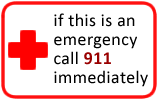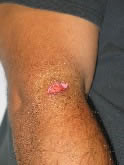Animal Bite
Animal Bite
Does this describe your symptoms? |
Click image for more info |
Definition
General Information
Types of Wounds
Types of Animal Bites
Wild Animals at risk for RABIES
Pet animals at higher risk for RABIES
|
First Aid:FIRST AID Advice for Bleeding: Apply direct pressure to the entire wound with a clean cloth. FIRST AID Advice for all Bites and Scratches: Wash all bite wounds and scratches with soap and warm water. |
When to Call Your Doctor |
Call 911 Now (you may need an ambulance) If |
|
|
|
Call Your Doctor Now (night or day) If |
|
|
|
Call Your Doctor Within 24 Hours (between 9 am and 4 pm) If |
|
|
|
Self Care at Home If |
|
|
HOME CARE ADVICE FOR MINOR ANIMAL BITE |
Minor Cuts and Scratches and Puncture Wounds
Bleeding: For any bleeding, apply continuous pressure for 10 minutes.
Cleansing: Wash all wounds immediately with soap and water for 5 minutes. Scrub the wound enough to make it re-bleed a little. Also, flush vigorously under a faucet for a few minutes (Reason: can prevent many wound infections).
Antibiotic Ointment: Apply an antibiotic ointment (e.g., Neosporin, Bacitracin) to the bite 3 times a day for three days.
Cleansing: Wash all wounds immediately with soap and water for 5 minutes. Scrub the wound enough to make it re-bleed a little. Also, flush vigorously under a faucet for a few minutes (Reason: can prevent many wound infections).
Call Your Doctor If:
Wound begins to look infected (redness, swelling, warmth, tender to touch, or red streaks)
You become worse
Minor Bruises
Treating Bruises:
Cold Pack for First 48 Hours: For bruises or swelling, apply a cold pack or an ice bag (wrapped in a moist towel) to the area for 20 minutes. Repeat in 1 hour, then as needed for the first 48 hours after the injury (Reason: to reduce the bruising, swelling, and pain).
Local Heat After 48 Hours: After 48 hours apply a warm moist washcloth or heating pad for 10 minutes three times a day to help absorb the blood.
Pain Medicines:
For pain relief, take acetaminophen, ibuprofen, or naproxen.
Acetaminophen (e.g., Tylenol):
Take 650 mg by mouth every 4-6 hours. Each Regular Strength Tylenol pill has 325 mg of acetaminophen.
Another choice is to take 1,000 mg every 8 hours. Each Extra Strength Tylenol pill has 500 mg of acetaminophen.
The most you should take each day is 3,000 mg.
Ibuprofen (e.g., Motrin, Advil):
Take 400 mg by mouth every 6 hours.
Another choice is to take 600 mg by mouth every 8 hours.
Use the lowest amount that makes your pain feel better.
Naproxen (e.g., Aleve):
Take 250-500 mg by mouth every 12 hours.
Use the lowest amount that makes your pain feel better.
Extra Notes:
Acetaminophen is thought to be safer than ibuprofen or naproxen in people over 65 years old. Acetaminophen is in many OTC and prescription medicines. It might be in more than one medicine that you are taking. You need to be careful and not take an overdose. An acetaminophen overdose can hurt the liver.
Caution: Do not take acetaminophen if you have liver disease.
Caution: Do not take ibuprofen or naproxen if you have stomach problems, kidney disease, are pregnant, or have been told by your doctor to avoid this type of medicine. Do not take ibuprofen or naproxen for more than 7 days without consulting your doctor.
Before taking any medicine, read all the instructions on the package
Expected Course: Bruises should fade away over 7-14 days.
Who Should Call Animal Control
Canada - Contacting the Public Health Department:
Public Health should be notified of any animal bite (or other animal contact) that might result in rabies.
If you go to the emergency department or to your doctor; they will call the Local Public Health Department.
If not, you should contact local Public Health Department in the area where the bite occurred.
United States - Contacting Animal Control:
The local Animal Control Center should be notified of any animal bite (or other animal contact) that might result in rabies.
If you go to the emergency department or to your doctor; they will call the Animal Control Center.
If not, you should contact the Animal Control Center in the county where the bite occurred.
Reporting Wild Animals and Strays
Canada: You can report the animal to the local medical officer of health and to the nearest CFIA veterinarian.
United States: You can report the animal to the animal control center for your county.
And remember, contact your doctor if you develop any of the "Call Your Doctor" symptoms.
Updated:
March 22, 2017





